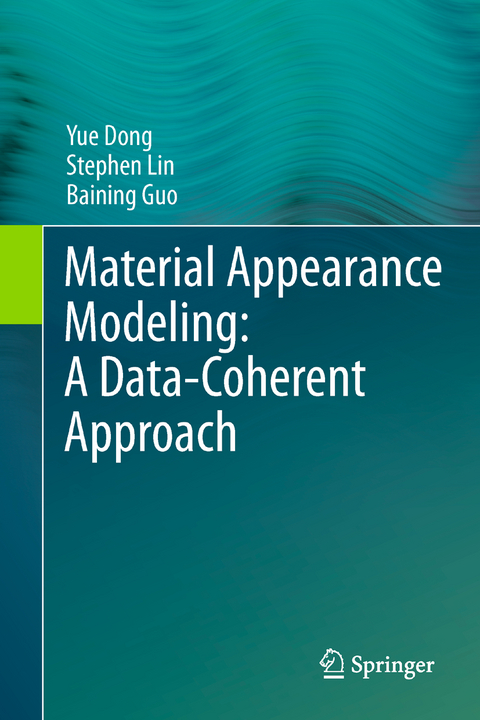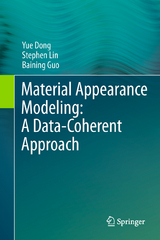Material Appearance Modeling: A Data-Coherent Approach
Springer Berlin (Verlag)
978-3-642-35776-3 (ISBN)
A principal aim of computer graphics is to generate images that look as real as photographs. Realistic computer graphics imagery has however proven to be quite challenging to produce, since the appearance of materials arises from complicated physical processes that are difficult to analytically model and simulate, and image-based modeling of real material samples is often impractical due to the high-dimensional space of appearance data that needs to be acquired.
This book presents a general framework based on the inherent coherency in the appearance data of materials to make image-based appearance modeling more tractable. We observe that this coherence manifests itself as low-dimensional structure in the appearance data, and by identifying this structure we can take advantage of it to simplify the major processes in the appearance modeling pipeline. This framework consists of two key components, namely the coherence structure and the accompanying reconstruction method to fully recover the low-dimensional appearance data from sparse measurements. Our investigation of appearance coherency has led to three major forms of low-dimensional coherence structure and three types of coherency-based reconstruction upon which our framework is built.
This coherence-based approach can be comprehensively applied to all the major elements of image-based appearance modeling, from data acquisition of real material samples to user-assisted modeling from a photograph, from synthesis of volumes to editing of material properties, and from efficient rendering algorithms to physical fabrication of objects. In this book we present several techniques built on this coherency framework to handle various appearance modeling tasks both for surface reflections and subsurface scattering, the two primary physical components that generate material appearance. We believe that coherency-based appearance modeling will make it easier and more feasible for practitioners to bring computer graphics imagery to life.
This book is aimed towards readers with an interest in computer graphics. In particular, researchers, practitioners and students will benefit from this book by learning about the underlying coherence in appearance structure and how it can be utilized to improve appearance modeling. The specific techniques presented in our manuscript can be of value to anyone who wishes to elevate the realism of their computer graphics imagery. For understanding this book, an elementary background in computer graphics is assumed, such as from an introductory college course or from practical experience with computer graphics.
Yue Dong is an associate researcher in the Internet Graphics Group of Microsoft Research Asia, where his work focuses mainly on appearance modeling with data coherency. He received his Ph.D. in Computer Science from Institute for Advanced Study at Tsinghua University in 2011, under the supervision of Professor Heung-Yeung Shum. Stephen Lin joined Microsoft Research Asia in June 2000 and is currently a Senior Researcher in the Internet Graphics group. His research lies in the fields of computer vision and computer graphics, with particular interests in computational photography, image processing, and photometric analysis. He has published over 80 papers and has served as a program co-chair of the International Conference on Computer Vision (ICCV) 2011 and the Pacific-Rim Symposium on Image and Video Technology (PSIVT) 2009. He received a B.S.E. in electrical engineering from Princeton University and a Ph.D. in computer science and engineering from the University of Michigan. Baining Guo is Assistant Managing Director of Microsoft Research Asia, where he also serves as the head of the graphics lab. Prior to joining Microsoft in 1999, Dr. Guo was a senior staff researcher with the Microcomputer Research Labs of Intel Corporation in Santa Clara, California. Dr. Guo received Ph.D. and M.S. from Cornell University and B.S. from Beijing University. Dr. Guo has published extensively in computer graphics and visualization, in the areas of texture and reflectance modeling, texture mapping, translucent surface appearance, real-time rendering, and geometry modeling. He served on the editorial boards of IEEE Transactions on Visualization and Computer Graphics. He is currently on the editorial boards of Computer and Graphics and IEEE Computer Graphics and Applications. He also served on program committees of most major graphics and visualization conferences, including ACM Siggraph, IEEE Visualization, Eurographics Symposium on Rendering, Pacific Graphics, ACM Symposium on Virtual Reality Software and Technology, and ACM Symposium on Solid and Physical Modeling. Dr. Guo has been granted over 30 US patents. Dr. Guo is a fellow of IEEE.
Introduction.- Surface Reflectance Overview.- Efficient SVBRDF acquisition with manifold bootstrapping.- Interactive SVBRDF Modeling from a Single Image.- Overview of Subsurface Light Transport.- Modeling subsurface light transport with the kernel Nystrom method.- Modeling and rendering subsurface scattering using diffusion equations.- Modeling textured translucent materials with lazy solid texture synthesis.- Overview of Material Fabrication.- Fabricating spatially-varying subsurface scattering.- Conclusion
| Erscheint lt. Verlag | 29.5.2013 |
|---|---|
| Zusatzinfo | X, 178 p. 96 illus., 92 illus. in color. |
| Verlagsort | Berlin |
| Sprache | englisch |
| Maße | 155 x 235 mm |
| Gewicht | 462 g |
| Themenwelt | Informatik ► Grafik / Design ► Digitale Bildverarbeitung |
| Mathematik / Informatik ► Informatik ► Software Entwicklung | |
| Informatik ► Theorie / Studium ► Künstliche Intelligenz / Robotik | |
| Schlagworte | appearance modeling • data coherence • Image-based modeling • material rendering • reflectance models |
| ISBN-10 | 3-642-35776-8 / 3642357768 |
| ISBN-13 | 978-3-642-35776-3 / 9783642357763 |
| Zustand | Neuware |
| Haben Sie eine Frage zum Produkt? |
aus dem Bereich




